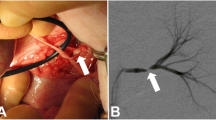Abstract
In this study a semi-automated and observer-independent algorithm for quantifying post-stenotic signal loss (PSL) in 3D phase-contrast (PC) magnetic resonance angiography (MRA) of patients with renal artery stenosis is presented. This algorithm was developed on MRA datasets of stenotic phantoms, which were included in a flow circuit with stationary flows. The length and the severity of the PSL (incorporating both length and degree of PSL) in the maximum intensity projections (MIPs) of MRA datasets were proposed for quantifying stenoses. The algorithm was tested in renal arteries of ten patients with renal artery stenosis and seven healthy volunteers. Digital subtraction angiography (DSA) was performed in the patients and served as the gold standard. Stenosis severity showed better correlation with the severity of the PSL than with the length, both for in vitro as in vivo. Spearman correlation coefficients (r S ) showed statistically significant correlations between the severity of the PSL and parameters determined by DSA, i.e. percent diameter stenosis (r S = 0.90). The length of the PSL showed no correlation with the diameter stenosis (r S = 0.37).
Similar content being viewed by others
References
Prince MR, Narasimham DL, Stanley JC, Chenevert TL, Williams DM, Marx MV, Cho KJ. Breath-hold contrast-enhanced MR angiography of the abdominal aorta and its major branches. Radiology 1995; 197: 785–792.
Siebert JE, Pernicone JR, Potchen JE. Physical principles and application of magnetic resonance angiography. Semin Ultrasound, CT and MRI 1992; 13: 227–245.
Takebayashi S, Ohno T, Tanaka K, Kubota Y, Matsubara S. MR angiography of renal vascular malformation. J Comput Assist Tomogr 1994; 18: 596–600.
Urchuk SN, Plewes DB. Mechanisms of flow-induced signal loss in MR angiography. J Magn Reson Imaging 1992; 2: 453–462.
Gatenby JC, McCauley TR, Gore JC. Mechanisms of signal loss in magnetic resonance imaging of stenoses. Med Phys 1993; 20: 1049–1057.
Gatenby JC, Gore JC. Mapping of turbulent intensity by magnetic resonance imaging. J Magn Reson Series B 1994; 104: 119–126.
Oshinski JN, Ku DN, Pettigrew RI. Turbulent fluctuation velocity: the most significant determinant of signal loss in stenotic vessels. Magn Reson Med 1995; 33: 193–199.
Wasser MN, Westenberg J, van der Hulst V, van Baalen J, van Bockel JH, van Erkel AR, Pattynama PMT. Hemodynamic significance of renal artery stenosis: digital subtraction angiography versus systolically gated three-dimensional phase-contrast MR angiography. Radiology 1997; 202: 333–338.
Debatin JF, Spritzer CE, Grist TM, Beam C, Svetkey LP, Newman GE, Sostman HD. Imaging of the renal arteries: value of MR angiography. AJR Am J Roentgenol 1991; 157: 981–990.
Sommer G, Noorbehesht B, Pelc N, Jamison R, Pinevich AJ, Newton L, Myers B. Normal renal blood flow measurement using phase-contrast cine magnetic resonance imaging. Invest Radiol 1992; 27: 465–470.
Lundin B, Cooper TG, Meyer RA, Potchen EJ. Measurement of total and unilateral renal blood flow by obliqueangle velocity-encoded 2D-cine magnetic resonance angiography. Magn Reson Imaging 1993; 11: 51–59.
Westenberg JJM, Wasser MNJM, van der Geest RJ, Pattynama PMT, de Roos A, Vanderschoot J, Reiber JHC. Variations in blood flow waveforms in stenotic renal arteries by 2D phase contrast cine magnetic resonance imaging. J Magn Reson Imaging 1998; 8: 590–597.
Parker DL, Parker DJ, Blatter DD, Du YP, Goodrich KC. The effect of image resolution on vessel signal in high-resolution magnetic resonance angiography. J Magn Reson Imaging 1996; 6: 632–641.
Van der Zwet PMJ, von Land CD, Loois G, Gerbrands JJ, Reiber JHC. An on-line system for the quantitative analysis of coronary arterial segments. Comput Cardiol 1990; 157–160.
Reiber JHC, van der Zwet PMJ, von Land CD, Koning G, van Meurs B, Buis B, van Voorthuisen AE. Quantitative coronary arteriography: equipment and technical requirements. In: Reiber JHC, Serruys PW, editors. Advances in quantitative coronary arteriography. Kluwer: Dordrecht, The Netherlands, 1993: 75–111.
Author information
Authors and Affiliations
Rights and permissions
About this article
Cite this article
Westenberg, J., van der Geest, R., Wasser, M. et al. Stenosis quantification from post-stenotic signal loss in phase-contrast MRA datasets of flow phantoms and renal arteries. Int J Cardiovasc Imaging 15, 483–493 (1999). https://doi.org/10.1023/A:1006329032742
Issue Date:
DOI: https://doi.org/10.1023/A:1006329032742




